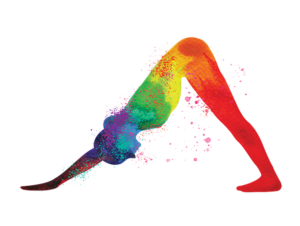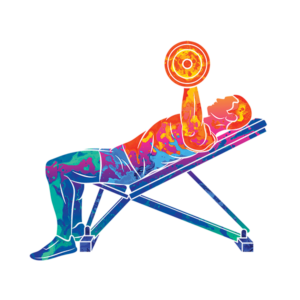T
here are four main forms of exercise: balance, endurance, flexibility, and strength. For optimal health, all four forms of exercise should be consistently included your weekly exercise regimen. However, according to the American Heart Association, you don’t have to do all four forms every day. Doing a variety of exercises throughout the week that incorporate these forms of exercise in one way or the other will not only keep you fit, but also keep your exercise routines anything but routine.1
 Balance
Balance
Overview. Having good balance is important because we use balance to do just about everything: we use it to stand, sit, walk, lean over, pull, push, reach, pick up, throw, catch…the list goes on and on. Having the ability to keep yourself steady and upright while performing any of these actions requires strength in your legs and core. Balance exercises can range from the very simple, such as practicing standing on one leg at a time, to very complicated, such as holding a tripod handstand with lotus legs yoga pose. But balance exercises generally do not involve running, jumping, or other high-impact motions; rather, balance training involves slow, methodical movements.2,3
Who can do it? Balance exercises can be practiced by anyone, regardless of age, fitness level, or physical limitations because the difficulty level of balance exercises is highly adjustable. Balance exercises are especially recommended for older individuals to help prevent falls.2,3
What areas of the body are targeted? Balance exercises should focus on one or more of the muscle groups used for balanced movements, such as the core, arms, legs, glutes, and back.3
What type of exercise is it? Balance exercises are primarily considered strength exercises for the glutes, legs, core, and back, though some balance exercises will work the chest and arm muscles. Balance exercises are also considered low impact because, again, they involve slow, methodical movements.3
How often can it be done? Balance exercises can be done every day by anyone of any fitness level or physical ability. The movements should be appropriate to your current physical ability.3
What are examples?3
• Standing with your weight on one leg and raising the other leg in front, to the side, or behind you
• Slowly walking heel to toe
• Standing up and sitting down from a chair without using your hands
• Alternate lifting your knees while walking
• Practicing yoga poses
As your balance and strength improve, increase the level of difficulty for each movement. Try the following:
• Hold a pose for a longer amount of time
• Add movement to a pose
• Close your eyes while practicing a pose or performing a movement
• Let go of your chair or other support while practicing a pose or performing a movement
 Endurance
Endurance
Overview. Endurance exercise is also called aerobic exercise and includes any activity that causes your breathing and heart rate go up. Endurance exercise is very important for your overall health because it strengthens your heart, lungs, and circulatory system and helps maintain your metabolism more than any other form of exercise. Regular endurance exercise also reduces the risk for many diseases, such as diabetes, heart disease, and stroke; improves immune functioning; strengthens bones; and relieves tension and anxiety. Endurance exercise is also, arguably, the most difficult form of exercise, especially for beginners, because it feels uncomfortable when your muscles demand more oxygen from your heart and lungs than they are used to producing. Endurance exercise should be performed at moderate- or high-intensity levels to ensure the heart rate and breathing increase.4,5
Who can do it? Endurance exercises can be practiced by anyone, regardless of age, fitness level, or physical limitations because the level of difficulty can be modified according to individual abilities. If you are an exercise beginner, have been sedentary for a long period of time, or have certain physical limitations, you will want to start easy with aerobic exercise (e.g., 10 to 15 minutes a day, 3 to 5 days a week, doing a moderately intense activity appropriate to your individual fitness level and ability) and gradually build intensity/difficulty (e.g., gradual increases in speed and/or distance) and amount of time doing the activity (e.g., gradually work up to 30 to 60 minutes a day, 5 to 7 days a week). Any type of movement can count as endurance exercise provided it is a nonstop activity that uses your large muscles and makes your heart and lungs work harder. 5–7
What areas of the body are targeted? Endurance exercises can target a variety of muscle groups—some activities only target on one or two areas, while other activities can target several areas at once. For example, walking targets the leg muscles and glutes, but not the core, back, or arm muscles, whereas running works the legs, glutes, core, and arms. Biking targets the core and leg muscles, but not the arms or back, while swimming targets core, back, glute, leg, and arm muscles. That’s why it is a good idea to practice a variety of aerobic activities, not only to reduce boredom but to make sure all muscle groups get worked every week.5
What type of exercise is it? Endurance exercise is considered an aerobic form of activity because it increases breathing and heart rate. The word aerobic actually means “requiring free oxygen.” However, endurance exercise is also considered strength-building because it requires the work of specific muscle groups to support the activity. Endurance exercise in some cases can also improve flexibility due to the range of motion needed to perform it, such as swimming or dancing. Endurance exercise can be low impact, such as walking or swimming, or high impact, such as running or step aerobics. The level of impact an endurance activity will have on the body is an especially important consideration for beginners, those who have been sedentary for a long period of time, and/or those with health conditions that limit mobility, such as pregnancy, overweight/obesity, joint or bone problems, or generally poor muscle tone. If the body parts involved in the physical activity are too weak to properly absorb the stress of impact, risk of injury will be higher. Starting easy and slowly increasing duration and difficulty will give the involved muscles, joints, tendons, and bones time to properly build the strength needed to support the weight of the body during physical activity.5,6
How often should it be done? The Centers for Disease Control and Prevention’s Physical Activity Guidelines for Americans recommends 150 minutes of moderate-intensity or 75 minutes of high-intensity aerobic (endurance) exercise per week for adults. For example, you could do 30 minutes of walking five days a week, or you could do 25 minutes of swimming three days a week, or you could do a total of 30 minutes of running that you break up into 10-minute intervals throughout the day three days a week. There really is an infinite number of variations in how you can break up your moderate- and/or high-intensity aerobic activities each week so long as you aim to meet the TOTAL number of minutes a week recommended by the CDC. If you plan your weekly exercise regimen according to your own interests, fitness level, physical abilities, and personal goals, you will be more likely to stick with it long-term.5-7
What are examples?6,7
• Walking
• Running
• Biking
• Hiking
• Swimming
• Dancing
• Cross country skiing
• Kickboxing
• Tennis
• Rowing
• Water aerobics
 Flexibility
Flexibility
Overview. As we age, our muscles shorten and lose elasticity, which limits our range of mobility. Sitting for long periods of time can also affect range of motion. Flexibility exercises, when practiced correctly, can offset these factors by stretching the muscles, which increases their range of motion. While flexibility exercises will not improve endurance or strength, they can improve your ability to perform endurance and strength exercises by improving your range of motion.8 However, it is important to note that flexibility—or stretching—exercises should only be done after physical activity, when the muscles are warm—this will facilitate deeper stretching without injuring the muscle tissue. If you only want to do stretching exercises, warm up your muscles first with a quick, moderately intense activity such a five-minute walk outside or on a treadmill or a doing a five-minute spin on a stationary bike.8
Who can do it? Flexibility exercises can be practiced by anyone, regardless of age, fitness level, or physical limitations because the level of difficulty can be modified according to individual physical abilities. Flexibility exercises generally do not involve running, jumping, or other high-impact motions; rather, like balance training, flexibility exercises involve slow, methodical movements.8
What areas of the body are targeted? Individual flexibility or stretching activities tend to focus on one area of the body at a time, such core, back, glute, arm, or leg muscle groups.9
What type of exercise is it? Like balance exercise, flexibility exercise is primarily considered a form of strength building and is low impact because it involve slow, methodical movements.9
How often can it be done? Flexibility exercises can be done every day by anyone of any fitness level or physical ability, but they should be modified according to one’s current physical ability. When stretching a muscle, the pose should be performed slowly and smoothly; you should feel a slight stretching sensation in the muscle, but it should feel comfortable, not painful. If you experience pain while stretching a certain muscle, then reduce the degree of stretching until you feel comfortable while still feeling a gentle stretch. Try to hold a stretching pose for 10 seconds at first, then slowly, over time, increase the degree of stretch or reach and the amount of time you hold the pose. Repeat a stretching pose 3 to 5 times per session and aim for eventually holding a stretch for 30 seconds, breathing normally.8
What are examples?10
• Tai chi
• Yoga
• Using a foam roller over muscles
• Dynamic lunges (bend one knee to the floor then the other)
• Calf stretches (place your toes on the edge of a step or stair and drop your heal down toward the next step or floor)
• Leg and lower back stretches (bend at the waist and reach for your toes [sitting or standing]
• Triceps stretches (bend one arm at the elbow behind your head, grasp the bent elbow with the opposite hand and gently pull it to toward the opposite side of your body)
• Standing hamstring stretch (place one leg straight out in front of you, and with your opposite leg bending at the knee, slowly lean forward)
 Strength
Strength
Overview. Strength training (also known as resistance training) is essentially defined as activities performed in repetition that make targeted muscles work against some form of resistance, thereby making muscles stronger. The resistance used can come in many forms: the weight of your own body, free weights, weight machines, resistance bands, weighted balls or bags, etc. Having stronger muscles can enhance your ability to perform everyday activities, decrease your risk of injury, and increase your metabolic rate.11
Who can do it? Strength training exercises can be practiced by anyone, regardless of age, fitness level, or physical limitations because level of resistance and range of motion can be modified according to an individual’s current fitness level and physical ability.11
What areas of the body are targeted? Strength training can be used to build core, back, glute, leg, and arm muscles. Individual strength training activities typically target specific muscles or muscle groups.11
What type of exercise is it? Strength training, as the name suggests, strengthens your muscles, bones, and connective tissues (e.g., tendons and ligaments). It’s safe to say that all endurance exercises are strength building, and all strength-building exercises are endurance or aerobic activities. However, strength training in and of itself does not have to be a high-impact or high-intensity activity. There are many weight-bearing exercises that are low impact and are performed using slow, smooth, methodical motions.11
How often can it be done? The American Heart Association recommends strength training for each muscle group at least twice per week, one set of 8 to 12 repetitions, with a minimum of two days of rest between workouts. Working the targeted muscles to the point of fatigue is usually sufficient.11
What are examples?
• lifting weights
• working with resistance bands
• heavy gardening, such as digging and shoveling
• climbing stairs
• hill walking
• cycling
• push-ups, sit-ups, and squats
• yoga
Bottom Line
Regular exercise that incorporates balance, endurance, flexibility, and strength building activities is important for overall health. All four types of exercise not need be done every day; doing each type a few times of week is beneficial to your health and will help keep your exercise routine more interesting. Aim to get at least 150 minutes of moderately intense or 75 minutes of highly intense exercise each week. Strength and endurance exercises can be broken down into several short sessions (e.g., 10 minutes at a time) over the course of the day or into longer sessions (30 to 60 minutes at a time) three to five times a week—the benefits are the same. Balance and flexibility exercises can be performed daily. Stretching should only be done on muscles that have been warmed up. Beginners, those who have been sedentary for a long period of time, and/or those with health conditions should start easy, build slowly, and select or modify activities suitable to their physical abilities.
Editor’s note: Consult with a qualified healthcare professional before starting a new exercise routine, especially if you are new to exercise, have been sedentary for a long period of time, or have a health condition.
Sources
1. American Heart Association. Fitness basics. https://www.heart.org/en/healthy-living/fitness/fitness-basics. Accessed 11 Jan 2022.
2. American Heart Association. Balance exercises. https://www.heart.org/en/healthy-living/fitness/fitness-basics/balance-exercise. Accessed 11 Jan 2022.
3. Watson S. Balance training. Reviewed by Wheeler T. 20 Nov 2020. Jumpstart by WebMD site. https://www.webmd.com/fitness-exercise/a-z/balance-training. Accessed 11 Jan 2022.
4. Morici G, Gruttad Auria CI, Baiamonte P, et al. Endurance training: is it bad for you? Breathe (Sheff). 2016 Jun; 12(2): 140–147.
5. Jumpstart by WebMD site. What Is Cardiovascular Endurance? Last reviewed by Brennan D 27 Nov 2021. https://www.webmd.com/fitness-exercise/what-is-cardiovascular-endurance#2. Accessed 13 Jan 2021.
6. American Heart Association site. Endurance exercise (aerobic). Last review 18 Apr 2018. https://www.heart.org/en/healthy-living/fitness/fitness-basics/endurance-exercise-aerobic. Accessed 13 Jan 2022.
7. United States Centers for Disease Control and Prevention. Physical Activity Guidelines for Americans, Second Edition. Washington, DC: US Department of Health and Human Services; 2018.
8. American Heart Association site. Flexibility exercise. Last reviewed 18 Apr 2018. https://www.heart.org/en/healthy-living/fitness/fitness-basics/flexibility-exercise-stretching. Accessed 14 Jan 2022.
9. Watson S. Yoga. Reviewed by Wheeler T 15 Dec 2021. Jumpstart WebMD site. https://www.webmd.com/fitness-exercise/a-z/yoga-workouts. Accessed 14 Jan 2022.
10. Weniger K. The 12 best flexibility exercises for improving your mobility. 23 August 2021. Last updated 25 Aug 2021. Institute for Integrative Nutrition site. https://www.integrativenutrition.com/blog/flexibility-exercises. Accessed 14 Jan 2022.
11. American Heart Association site. Strength and resistance training exercise. Last reviewed 19 Apr 2018. https://www.heart.org/en/healthy-living/fitness/fitness-basics/strength-and-resistance-training-exercise. Accessed 14 Jan 2022 .





